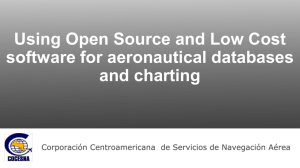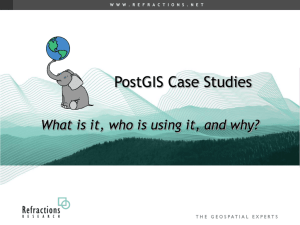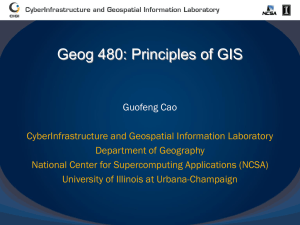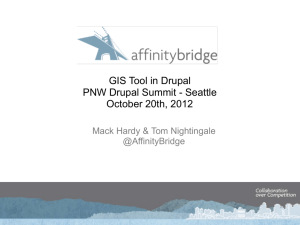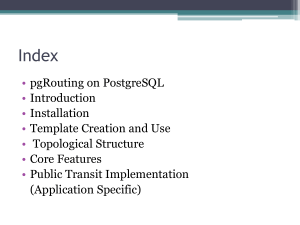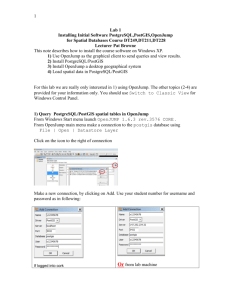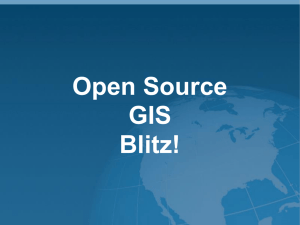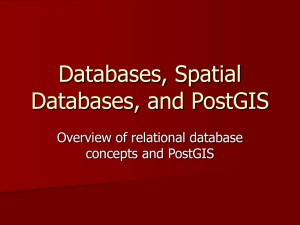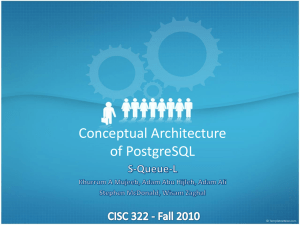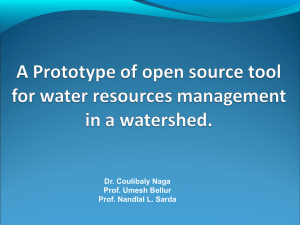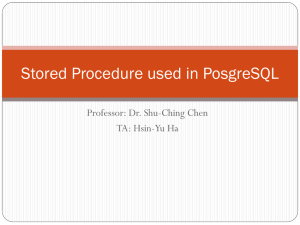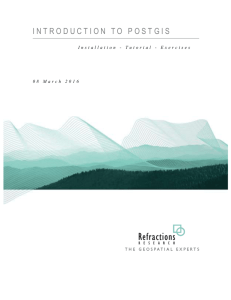Connect to the PostgreSQL/PostGIS databases
advertisement
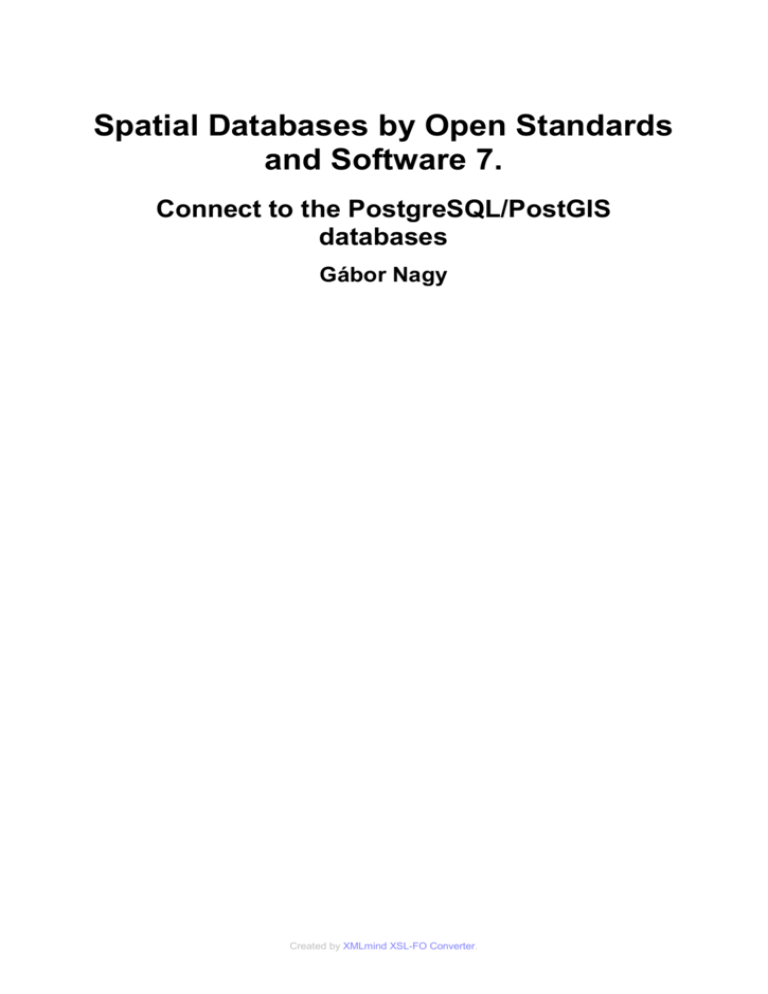
Spatial Databases by Open Standards
and Software 7.
Connect to the PostgreSQL/PostGIS
databases
Gábor Nagy
Created by XMLmind XSL-FO Converter.
Spatial Databases by Open Standards and Software 7.: Connect
to the PostgreSQL/PostGIS databases
Gábor Nagy
Lector: Zoltán Siki
This module was created within TÁMOP - 4.1.2-08/1/A-2009-0027 "Tananyagfejlesztéssel a GEO-ért"
("Educational material development for GEO") project. The project was funded by the European Union and the
Hungarian Government to the amount of HUF 44,706,488.
v 1.0
Publication date 2010
Copyright © 2010 University of West Hungary Faculty of Geoinformatics
Abstract
Connect to an PostGIS/PostgreSQL database from different applications
The right to this intellectual property is protected by the 1999/LXXVI copyright law. Any unauthorized use of this material is prohibited. No
part of this product may be reproduced or transmitted in any form or by any means, electronic or mechanical, including photocopying,
recording, or by any information storage and retrieval system without express written permission from the author/publisher.
Created by XMLmind XSL-FO Converter.
Table of Contents
7. Connect to the PostgreSQL/PostGIS databases ..............................................................................
1. 7.1 Introduction .....................................................................................................................
2. 7.2 Connecting from desktop GIS applications .....................................................................
2.1. 7.2.1 QGIS ................................................................................................................
2.2. 7.2.2 uDIG ................................................................................................................
3. 7.3 Connecting from web applications ..................................................................................
3.1. 7.3.1 MapServer .......................................................................................................
3.2. 7.3.2 GeoServer ........................................................................................................
4. 7.4 Connecting from simple script programs ........................................................................
iii
Created by XMLmind XSL-FO Converter.
1
1
1
1
3
7
7
8
8
Chapter 7. Connect to the
PostgreSQL/PostGIS databases
1. 7.1 Introduction
In this module we learn how to connect to an PostgreSQL/PostGIS database, and access the stored geospatial
data.
The connecting applications may be desktop GIS software, web based maps, WMF and WFS servers, or simple
custom programs. This module introduces some usable solutions for these connections.
Every connection, independent of the connected program, needs some data: the location of the server (IP
address or host name, and the port if it is different from 5432, the default value), the name of the database (a
database server may have more databases) and the name of the user. Optionally the connection requires the type
of the connection (we can use SSL for the safe data transfer) or authentication data (for example the password of
the user).
Most PostGIS clients use the geometry_columns table. The clients use this table to discover the available
geospatial data in the database. This table is modified when we use AddGeometryColumn() and
DropGeometryColumn() functions to create or remove a geometry type column. We should use these functions,
and don't forget to grant at least SELECT privilege to the client’s user on the geometry_column and the
spatial_ref_sys tables.
2. 7.2 Connecting from desktop GIS applications
2.1. 7.2.1 QGIS
Quantum GIS (QGIS) is an Open Source Geographic Information System (GIS) licensed under the GNU
General Public License. QGIS is an official project of the Open Source Geospatial Foundation (OSGeo). It runs
on Linux, Unix, Mac OSX, and Windows and supports numerous vector, raster, and database formats and
functionalities.
(http://qgis.org/)
We can define more named connections to store the required connection data: the location and the port number
of the server, the name of the database and the name of the user.
1
Created by XMLmind XSL-FO Converter.
Connect to the PostgreSQL/PostGIS
databases
Figure 1. Create new PostGIS connection in QGIS
We could choose a geospatial table from the connected database. The chosen tables can be added to the QSIG
project as vector layers.
2
Created by XMLmind XSL-FO Converter.
Connect to the PostgreSQL/PostGIS
databases
Figure 2. Add a PostGIS table to QGIS as layer
If a table has more geometry type columns (and these columns are registered in the geometry_columns table),
then the list contains more lines for this table.
The PostGIS layers are vector layers in the QGIS. The QGIS users can edit these layers. The modification will
be sent to the database, when the user turns off editing.
2.2. 7.2.2 uDIG
uDig is an open source (LGPL) desktop GIS application framework, built with Eclipse Rich Client (RCP)
technology.
(http://udig.refractions.net/)
3
Created by XMLmind XSL-FO Converter.
Connect to the PostgreSQL/PostGIS
databases
Figure 3. Add PostGIS data to the uDIG, Step 1
In the first step PostGIS is chosen from the data sources. The uDIG supports several other types of data sources.
4
Created by XMLmind XSL-FO Converter.
Connect to the PostgreSQL/PostGIS
databases
Figure 4. Add PostGIS data to the uDIG, Step 2
In the second step, the connection data is given to the database server. The location and the port of the database
server and the name of the database user are needed.
5
Created by XMLmind XSL-FO Converter.
Connect to the PostgreSQL/PostGIS
databases
Figure 5. Add PostGIS data to the uDIG, Step 3
In the third step we set the name of the database, and choose the spatial tables from the list.
6
Created by XMLmind XSL-FO Converter.
Connect to the PostgreSQL/PostGIS
databases
Figure 6. Add PostGIS data to the uDIG, Step 4
In the last step click the “Finish” button, and the uDIG opens the selected spatial data sources.
3. 7.3 Connecting from web applications
3.1. 7.3.1 MapServer
MapServer is an Open Source platform for publishing spatial data and interactive mapping applications to the
web. Originally developed in the mid-1990’s at the University of Minnesota, MapServer is released under an
MIT-style license, and runs on all major platforms (Windows, Linux, Mac OS X).
(http://mapserver.org/)
MapServer uses text configuration files (called mapfiles) to describe the distributed maps. This mapfile contains
the properties of the map, the layers with the display settings and the data sources. The vector layers of the
MapServer may be an PostGIS table.
For example a mapfile, which has a PostGIS based layer:
7
Created by XMLmind XSL-FO Converter.
Connect to the PostgreSQL/PostGIS
databases
MAP
NAME "counties"
STATUS ON
SIZE 600 400
SYMBOLSET "../etc/symbols.txt"
EXTENT 400 0 1000 400
UNITS meters
IMAGECOLOR 255 255 255
FONTSET "../etc/fonts.txt"
WEB
IMAGEPATH "/ms4w/tmp/ms_tmp/"
IMAGEURL "/ms_tmp/"
END
LAYER
NAME "counties"
STATUS ON
TYPE POLYGON
CONNECTIONTYPE POSTGIS
CONNECTION "host=127.0.0.1 port=5432 dbname=gisdata user=gisdata_client"
DATA "geom from county"
CLASS
NAME
'Counties'
STYLE
OUTLINECOLOR
0 0 0
END
END
END
END
3.2. 7.3.2 GeoServer
GeoServer is an open source software server written in Java that allows users to share and edit geospatial data.
Designed for interoperability, it publishes data from any major spatial data source using open standards.
GeoServer is the reference implementation of the Open Geospatial Consortium (OGC) Web Feature Service
(WFS) and Web Coverage Service (WCS) standards, as well as a high performance certified compliant Web
Map Service (WMS). GeoServer forms a core component of the Geospatial Web.
(http://geoserver.org/)
The GeoServer has a complex web based administration interface. We can specify the PostGIS based layers of
the maps, and PostGIS based WFS services through this user interface.
4. 7.4 Connecting from simple script programs
Here is a simple Ruby script, which connects to a PostgreSQL/PostGIS database, and creates point object in the
points table from a text file:
require 'postgres'
dbconn=PGconn.connect('localhost', 5432, '', '', 'gisdata', 'gisdata_client')
File.open('survey.kor').each do |coordfilerow|
fields=coordfilerow.chomp.split
pnum=fields[0]
geomWKT="POINT(#{fields[1]} #{fields[2]} #{fields[3]})"
if fields.size==4 then
dbconn.exec("INSERT INTO points (pn, geom) VALUES
('#{pnum}', GeomFromEWKT('SRID=23700;#{geomWKT}'));")
end
end
dbconn.close
Another Ruby script, which searches for a point by point number in the table, which was filled by the previous
script:
8
Created by XMLmind XSL-FO Converter.
Connect to the PostgreSQL/PostGIS
databases
require 'postgres'
dbconn=PGconn.connect('localhost', 5432, '', '', 'gisdata', 'gisdata_client')
print "The number of the point:"
pnum=gets.chomp
dbconn.exec("SELECT ST_X(geom), ST_Y(geom), ST_Z(geom)
FROM points WHERE pn='#{pnum}';").each do |point|
puts "Y=#{point[0]} X=#{point[1]} Z=#{point[2]}"
end
dbconn.close
Bibliography
PostgreSQL Global Development Group: 1996-2010.
Refractions Research Inc.: PostGIS 1.5.2 manual, 2010.
9
Created by XMLmind XSL-FO Converter.
